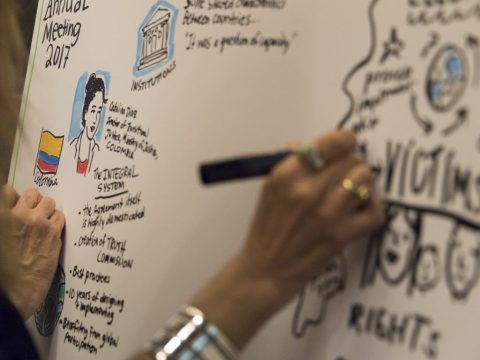
Investing in Proximate Peacebuilding
Humanity United is committed to cultivating the conditions for enduring peace and freedom. This month marks the launch of our refreshed peacebuilding strategy that supports...

The current global landscape is dominated by rising authoritarianism, shrinking civil society space, and a new Cold War mentality. Peace and security trends have continually worsened since 2020, as violence and fragility have risen sharply, and nearly every indicator of democracy and positive peace has deteriorated significantly, strongly impacting our partners. In this reality, we believe that all those working for peace must include the creativity and energy of people at every level of the system.
Our Peacebuilding Portfolio recognizes that current approaches to peacebuilding and conflict prevention are often ineffective because of a significant power imbalance at the heart of the global peacebuilding system. The field of peacebuilding has increasingly relied on “top-down” strategies that reinforce the agency and decisions of those with institutional power, while ignoring the expertise of proximate actors and perpetuating transactional relationships.
After more than a decade of work on peace, justice, and conflict transformation, we know that those working at the frontlines of peace hold the deep expertise, knowledge, and relationships necessary to transform their societies. Unfortunately, their power and voice is often intentionally excluded from the decisions that directly impact them. Our goal is to support and amplify the work of proximate peacebuilders, while at the same time influencing global peacebuilding, philanthropy, and policy systems to be more responsive to proximate agency and power. We recognize that peace is not simply the absence of war, but a process for restoring human dignity and creating societies that can manage conflict, resist shocks, and promote the agency and power of all citizens.
Our ultimate vision is a transformed global system in which international cooperation on peacebuilding is defined and driven by the agency and power of proximate peacebuilders. To make progress toward that vision, we support sustainable networks that contribute to an ecosystem where proximate actors can make meaningful change in their own contexts and begin to spark global change.
Our Peacebuilding strategy focuses on long-term efforts to increase the agency and power of proximate actors and to generate more inclusive and durable solutions to violence. In assessing the needs of the current context, along with our resources, expertise, and existing relationships, we have chosen to center our grantmaking on four focus areas, with a commitment to two geographic regions: Colombia and South Sudan.
Our focus areas are: Agency for Collective Action, Innovative Pathways for Peace, Inclusive Peace Processes, and Healing and Well-Being.

Our geographic partners are fully embedded into our thematic focus areas, creating opportunities for more fluid collaboration and learning across themes in the portfolio, as well as allowing us to experience together how the four focus areas play out in unique and intertwined ways.
Why Use the Term Proximate Peacebuilder?
In past strategies, the Peacebuilding Portfolio has used the term “local peacebuilders.” Based on reflection and feedback from our partner network, we are transitioning to the term “proximate peacebuilders” to refer to those who are closest to and most impacted by conflict extending beyond professional and institutional actors to everyday individuals across industries, experiences, and contexts who exert agency over conflicts in their own lives and communities.
This change is based on the fact that the term “local” is: 1) often used to refer exclusively to grassroots or community actors, which erases those people with lived experience of conflict who may be working at different levels of the system; 2) used in an increasingly pejorative manner to minimize the expertise of actors from conflict regions and further reinforce divides between traditional power holders and those who directly experience conflict; and 3) used to exclude migrants and displaced persons from critical conversations.

Humanity United is committed to cultivating the conditions for enduring peace and freedom. This month marks the launch of our refreshed peacebuilding strategy that supports...

The world today looks very different than it did when we announced our commitment to our portfolio work a few years ago. Over the next...

HU and the Kroc Institute for Peace will hold a panel discussion where speakers will share their experiences on multiple truth commission inquiries.